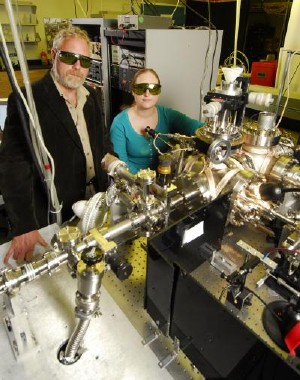Sep 26 2008
Understanding biology at the systems level is difficult, especially when studying complex specimens like tissue slices or communities of organisms in a biofilm. Scientists must be able to identify, quantify and locate the molecules present in the samples.
 Georgia Tech School of Chemistry and Biochemistry professor Thomas Orlando and graduate student Irene Anestis-Richard conduct an experiment with the single photon ionization mass spectrometer. Credit: Georgia Tech Photo: Gary Meek
Georgia Tech School of Chemistry and Biochemistry professor Thomas Orlando and graduate student Irene Anestis-Richard conduct an experiment with the single photon ionization mass spectrometer. Credit: Georgia Tech Photo: Gary Meek
At Georgia Tech, researchers from the Colleges of Sciences and Engineering have joined forces to create the Center for Bio-Imaging Mass Spectrometry (BIMS), which aims to tackle these types of challenges.
"We organized this center in 2007 when we saw the enormous potential of mass spectrometry imaging tools and realized that we had a unique ensemble of people at Georgia Tech that would enable us to excel in this field," said Al Merrill, a professor in the School of Biology and the Smithgall Chair in Molecular Cell Biology.
Mass spectrometry imaging is a powerful analytical technique with the potential to unravel the molecular complexities of biological systems. It allows researchers to visualize the spatial arrangement and relative abundance of specific molecules – from simple metabolites to peptides and proteins – in biological samples.
The technique also takes advantage of the ability of biological molecules to be converted into ions that can then be separated and analyzed by a mass spectrometer. When data are collected from different regions of a sample, the distribution of molecules can be used to create multidimensional images of that sample.
The researchers used an oscillating capillary nebulizer to spray small droplets of matrix aerosol onto the sample surface – a process similar to airbrushing. Using histological samples provided by Timothy Cox, a professor of medicine at the University of Cambridge, the researchers could profile and localize many different lipid species in the samples. Specifically, they localized sphingolipids that accumulate in the brain when there is a genetic defect. This research was funded by the National Institutes of Health.
While MALDI samples must be analyzed in a vacuum, recent advances allow samples to be studied under ambient conditions. Facundo Fernandez, an assistant professor in the School of Chemistry and Biochemistry, has been using a technique called desorption electrospray ionization (DESI).
With DESI, a high-speed, charged spray containing alcohol and water is directed at a sample a few millimeters away. The solvent droplets pick up portions of the sample through interaction with the surface and then form highly charged ions that can be analyzed.
Fernandez and his research team recently used DESI to analyze nearly 400 drug samples provided by public health authorities to identify counterfeit anti-malarial drugs. Activities aimed at addressing the widespread problem of counterfeit anti-malarial drugs were reported February 12th in the journal PLoS Medicine. Georgia Tech's efforts to develop faster analytical techniques were sponsored by the U.S. National Science Foundation, while the sample analysis was supported by a small grant from the World Health Organization.
"We've focused on researching computational methods that can clean up, visualize and look for interesting patterns in thousands of mass spectrometry tissue images that you wouldn't necessarily be able to find or have time to find with the naked eye," explained May Dongmei Wang, an assistant professor in the Wallace H. Coulter Department of Biomedical Engineering and a Georgia Cancer Coalition Distinguished Cancer Scholar.
With the advances in software and hardware, the use of mass spectrometry in the life sciences promises to become even more prevalent and diversified for systems biology research.
Posted September 26th, 2008